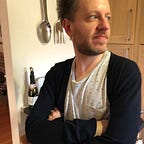Creative discomforts
If you’ve ever sat in a creative session and felt awkward and uncomfortable, I’ve got good news for you — you’re likely about to come up with your most original and least predictable ideas.
As I’ve got older and the years I spend in agency land tick by, I tend to regularly revert to old ideas. Bringing out the old classics, the tried and tested — sometimes I even bore myself with my lack of imagination. To get past these, I’ve tried a bunch of techniques to inject some freshness — walking different routes (big thanks to Nick Hearne for this one), making some music, broadening my sources of inspiration beyond the obvious (and thanks to Gareth Leeding for that one). But according to two academic studies I read recently, what I should be doing is creating a sense of psychological discomfort.
That might not sound like much fun. But trust me, I’ve been to a LOT of brainstorms, and I once brainstormed non-stop for over 42 hours. In my experience, they follow a similar pattern — you start with loads of energy, as the folks who’ve done some prep share their pre-baked thinking. Builds, fresh ideas for a while, before inertia sets in — as indicated by moments of awkward silence where no one’s sure if attendees are thinking about the brief or pondering what to have for lunch. At this point, the facilitator senses the awkward vibe of the room and says, “well, I think we’ve got some great ideas there” (even if they haven’t) and calls proceedings to a close.
In that situation, you should face the awkwardness and keep going — your best ideas are still to come. With any brainstorm or creative session, the concepts that appear most readily are the most obvious ones. That’s not a judgement on your ideas. And it doesn’t mean they’re wrong; because they came first, they’re statistically likely to lack originality. That’s according to a series of scientific studies covered in Kellogg Insight; the study shows that our brains associate creativity with the ease of generating ideas. When it becomes more challenging to develop a new idea, we think the outputs will be less creative (the reverse of ease = creativity).
Across three different research groups, scientists consistently found that participants THOUGHT their ideas were less creative the longer sessions lasted. Still, the ideas participants generated last were consistently rated as MORE creative by an independent group not involved in the sessions. Creativity is the ability to connect the seemingly unconnected to create something new and exciting — the more tangential and abstract that connection, the more original your idea.
So the advice is clear. To get better ideas:
- Keep going.
- Learn to embrace the awkwardness in the room (whether physical or virtual).
- Give people more time to work on ideas — don’t just settle for what you’ve got.
And according to a separate strand of research, awkwardness and discomfort could further enhance your creativity and the power of your ideas. In the studies, researchers artificially created a sense of mind-body dissonance. They asked participants to “think of a happy or sad experience they had gone through and to then write about it while either smiling or frowning”. After that, participants attempted a series of creative tasks — again, independent judges of the creative output found those who experienced MBD (mind-body dissonance) came up with more novel ideas.
The logic behind these findings suggests that creating a sense of MBD made participants more open to novel, unique and unusual combinations — taking us back to that same philosophy of connecting the seemingly unconnected. We often like to mysticise the creative process — we imagine killer ideas coming out of the ether, fully formed, like the world’s most idyllic birth experience. But look beneath any idea that appears effortless, and you’ll find buckets of blood, sweat and tears.
One of the most written about parts of the recent Beatles Get Back documentary was the scene where Paul comes up with the song Get Back through sheer force of will. And as plenty of people wrote at the time of release, it truly is a special moment to watch a great songwriter coming up with a great song in real-time. But what the documentary doesn’t show or mention is the likely hours Paul put in before turning up at Twickenham studios. There are plenty of moments throughout Get Back’s eight-hour running time where The Beatles come into the studio with a half-formed idea that they then work through together (George’s Old Brown Shoe, for example). Paul will likely have been noodling over Ger Back’s chord pattern or melody for a while, and the uncomfortable environment of a draughty film studio creates prime conditions to realise those vaguely formed notions. That song didn’t just come from nowhere — time, energy, experience, thoughts, feelings, and emotions built up as it eventually made its way into the world.
Luckily for those working in comms, we’re not facing the same challenge as The Beatles and don’t have to write and record an album in four weeks. But coming up with genuinely new ideas is a challenge — and those ideas do need the right time and environments to come to life. So don’t give yourself a break when they don’t come easily — keep going; your best truly is yet to come.
